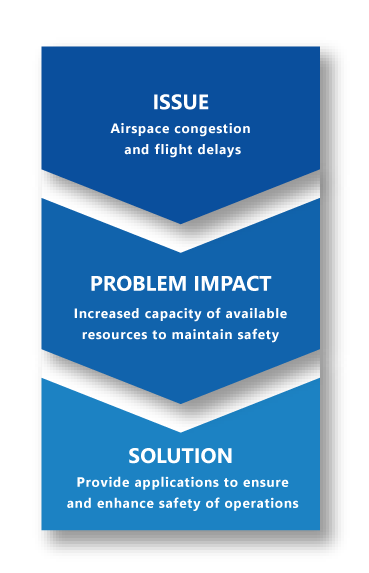![]() 5D-AeroSafe Facts & Figures
5D-AeroSafe Facts & Figures
- 5D-AeroSafe – „5 services of Drones for increased airports and waterways safety and security”
- MG-2-8-2019 – Innovative applications of drones for ensuring safety in transport
- Grant Agreement number: 861635
- Total Funding: € 3 799 911,25
- EC Requested Funding: € 3 497 475
- Timeframe: 01.06.2020 – 30.11.2023
- Consortium: 10 partners from 6 MS (3 RTO, 1 UNI, 3 SMEs and 3 END-USERS)
![]() Project Motivation
Project Motivation
- Disturb airline and airport operations.
- Considerable inconvenience to passengers.
- Pose significant safety concerns.
- Cause financial losses to airlines, airports and aviation authorities.
- Maintaining safety and security of the involved stakeholders as a first priority.
- More efficient airtransport services and available resources.
The solution:
- Provide services for the safety and security of air traffic and airport management.

![]() Project scope
Project scope
The main scope of 5D-AeroSafe is to develop a solution for the safe and efficient integration of UAS in airport and waterway daily operations, that will:
- Conduct Flight Inspections, i.e. inspections and calibrations on CNS (Communication, Navigation and Surveillance) systems and landing visual aids;
- Safeguard airport restricted areas,
- Inspect runways and taxiways (and water runways) to detect Foreign Object debris or any other threat to aircraft movement on the ground (and water surface).
![]() Project challenges
Project challenges
5D-AeroSafe will study and implement UAS-based solutions to enhance the airport operations in the domain of:
- Sensors calibration: the project will develop a sensor that will be embedded on a UAV (to replace the calibration with piloted aircraft – more expensive due to aircraft and pilots).
- Platform safety: the UAVs equipped with cameras will inspect the runways and taxiways (resp. waterways) to detect anomalies (FODs or defects) that could raise problems to the aircraft movements (to replace inspections by teams in car, longer and more expensive).
- Platform security: similarly, the system will search for abnormal behaviors of persons or vehicles in the perimeter of the airport and in the vicinity.
![]() Ultimate result
Ultimate result
Platform built as part of the established UTM
Conforming to the applicable regulations, and the services and procedures described in the U-Space framework as well requirements of the involved shareholders, 5D-AeroSafe, based on the development of appropriate functions, will provide an application portal as well as a toolbox with APIs and packages ready to supply the “5-Dimensions” of 5D-AeroSafe.

![]() Project results
Project results
The UAVs will operate in an area where potential conflicts are numerous, so the 5D-AeroSafe system needs to take care about the safe integration with ATM and ground movements:
- A Generic Ground Control Station (GGCS) manages all the UAV missions through an integration of the respective specific Ground Control Stations. The missions received from the tower are allocated to the UAVs with a preliminary mission preparation that will be completed at GCS level. In the other way round, the data received from the UAVs are exploited at GCS and GGCS level to send the mission report to the tower.
- The 5D-AeroSafe platform will manage the UAV missions (UTM).
- Seamless UTM/ATM coordination for non-segregated airspace.
![]() Technical challenges
Technical challenges
- Development of a calibration sensor that can be integrated in the project UAVs.
- Adaptation of UAVs to fulfill the project missions.
- Development of a GGCS able to manage the project missions.
- Development of a UTM platform for airport operations.
- Integration of UTM and ATM through the connection with the airport legacy systems.
![]() CONOPS
CONOPS
To provide the uses cases and scenario definitions for the pilots, forming the concept of operations of the system (CONOPS)
- To determine the list of requirements and associated KPIs for the 5DAeroSafe solution from the users’ perspective.
- To investigate adherence to the relevant regulatory frameworks (ICAO Annex 10, ΙCAO Doc 8071, NPA 2017- 05) and its application to the resulting system and to examine potential ethical/legal aspects for implementing the UTMS at airports.
